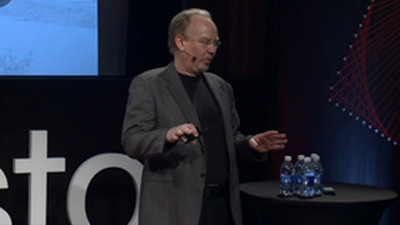(单词翻译:单击)
听力文本
Maybe not the way people dress, but you know, the question now is, how can we have all the good things that we identify with cities without all the bad things?
人们的衣着可能不会是这样,但要知道,现在的问题是,我们要如何对于城市带给我们的产物做到取其精华去其糟粕呢?
This is Bangalore. It took me a couple of hours to get a few miles in Bangalore last year.
这儿是班加罗尔,在去年的时我花了好几小时才在班加罗尔移动了几英里。
So with cities, you also have congestion and pollution and disease and all these negative things.
所以在城市里,有拥挤和污染有疾病还有很多负面的东西。
How can we have the good stuff without the bad?
怎样取其精华去其糟粕呢?
So we went back and started looking at the great cities that evolved before the cars.
我们暂且回头看看那么比较不错的城市吧,在有了汽车之前的状态。
Paris was a series of these little villages that came together, and you still see that structure today.
巴黎就是由好些小村庄合并而成的,这种分布结构你今天还可以看得出来。
The 20 arrondissements of Paris are these little neighborhoods.
巴黎的20个区就像20个小邻居。
Most of what people need in life can be within a five- or 10-minute walk.
大多数人们的生活所需或许就在5到10分钟的步行范围里。
And if you look at the data, when you have that kind of a structure,you get a very even distribution of the shops and the physicians and the pharmacies and the cafes in Paris.
如果你去看那些数据,当你建立了这种结构后,巴黎的商店,内科医生,药房,还有咖啡厅都会很平均地分布在城市中。
And then you look at cities that evolved after the automobile, and it's not that kind of a pattern.
之后你再看那些拥有了汽车后的城市,他们就完全不是这个模式了
There's very little that's within a five minute walk of most areas of places like Pittsburgh.
像匹兹堡,大部分地方很少再有几步之遥的生活了。
Not to pick on Pittsburgh, but most American cities really have evolved this way.
不单是匹兹堡,大部分美国的城市都演变成这个样了。
So we said, we'll, let's look at new cities, and we're involved in a couple of new city projects in China.
所以我们说,看看这些新城市,我们也要在中国弄几个新城市出来。
So we said, let's start with that neighborhood cell.
那我们就从社区单元开始着手吧。
We think of it as a compact urban cell.
我们觉得这是一种紧凑的城市单元。
So provide most of what most people want within that 20-minute walk.
这样大部分人就能在20分钟步程内满足生活所需。
This can also be a resilient electrical microgrid,community heating, power, communication networks,etc., can be concentrated there.
这也能成为一种有弹性的微电网,社区供热网,电力网,通讯网,等等,都能集中在那儿。
Stewart Brand would put a micro-nuclear reactor Stewart Brand right in the center, probably.
很可能会在正中心建一个原子核反应堆。
And he might be right.
他或许是对的。
And then we can form, in effect, a mesh network.
事实上,我们就能形成一个网状网络了。
It's something of an Internet typology pattern,so you can have a series of these neighborhoods.
这是一种类型学的互联网模式,所以我们有了这一系列的社区。
You can dial up the density about 20,000 people per cell if it's Cambridge. Go up to 50,000,if it's Manhattan density. You connect everything with mass transit and you provide most of what most people need within that neighborhood.
你可以了解到人口密度,如果在剑桥大概就是每个社区2万人。如果是在曼哈顿,这个数字就是5万。我们把那些大的中转点连接起来,这样单在社区里就能满足很多人的需求了。
You can begin to develop a whole typology of streetscapes and the vehicles that can go on them. I won't go through all of them. I'll just show one.
我们也能开创一个新的类型学包含了街景和交通工具,我就不详讲,我就说一个方面。
This is Boulder. It's a great example of kind of a mobility parkway, a superhighway for joggers and bicyclists where you can go from one end of the city to the other,without crossing the street, and they also have bike-sharing,which I'll get into in a minute.
这里是博尔德,它的驾车专用道路,还有跑步者和自行车者的高速公路,是很有代表性的,你可以顺着它横穿整个城市,不用过马路,而且他们也有公共自行车能让我很快就适应进去。
This is even a more interesting solution in Seoul, Korea.
在韩国首尔,还有个更有趣的解决方案。
They took the elevated highway, they got rid of it,they reclaimed the street, the river down below,below the street, and you can go from one end of Seoul to the other without crossing a pathway for cars.
他们放弃了高架公路,重新回到街道上,还有街道下面的小河流,这样不用穿过马路就能从首尔的一端到达另外一端。
The Highline in Manhattan is very similar.
曼哈顿的高压线也是类似的情况。
You have these rapidly emerging bike lanes all over the world. I lived in Manhattan for 15 years.
在全世界,我们拥有这种迅速面世的单车道,我在曼哈顿住了15年。
I went back a couple of weekends ago, took this photograph of these fabulous new bike lanes that they have installed.
上几个周末我回去了一趟给这些新建的漂亮的单车道拍了些照。
They're still not to where Copenhagen is, where something like 42 percent of the trips within the city are by bicycle.
比起哥本哈根,仍有些差距在哥本哈根,42%的路程都是在单车上的。
It's mostly just because they have fantastic infrastructure there.
很有可能是他们那里有更好的基础设施。
We actually did exactly the wrong thing in Boston.
在波士顿我们完全做了错误的事。

We,the Big Dig,so we got rid of the highway but we created a traffic island and it's certainly not a mobility pathway for anything other than cars.
我们—那个大隧道,我们是摆脱了高速公路,但我们也制造了交通岛显然除了汽车,它还真的不适用于其他的交通工具。
Mobility on demand is something we've been thinking about, so we think we need an ecosystem of these shared-use vehicles connected to mass transit.
我们一直在思考迫在眉睫的流动性问题,我们觉得我们需要一个公交生态系统,他们可以将那些大的中转站给连接起来
These are some of the vehicles that we've been working on.
这些是我们目前着手的一些交通工具。
But shared use is really key. If you share a vehicle,you can have at least four people use one vehicle,as opposed to one.
公共使用是关键,如果我们共用一辆车,那么相对一个人使用一辆车来说,这辆车的使用人数至少可以是四人。
We have Hubway here in Boston, the Velib' system in Paris.
在波士顿我们有Hubway。自行车共享系統,在巴黎有Velib系统。
We've been developing at the Media Lab this little city car that is optimized for shared use in cities.
我们在媒体实验室研发这种城市小车,可以在城市充分共享使用。
We got rid of all the useless things like engines and transmissions. We moved everything to the wheels,so you have the drive motor, the steering motor,the breaking all in the wheel.
我们摒弃了那些没什么用处的东西,像引擎还有传动装置,我们把一切都搬到轮子上,所以车上的轮子就集成有驱动马达,转向电机,和刹车系统。
演讲视频
要怎样才能使更多的人住进城市中,而不显得过分拥挤呢?Kent Larson展示了折叠汽车,可快速调整的公寓,还有其他的创新作品,他们都能使得城市变得和以前的小村庄一样舒适。


